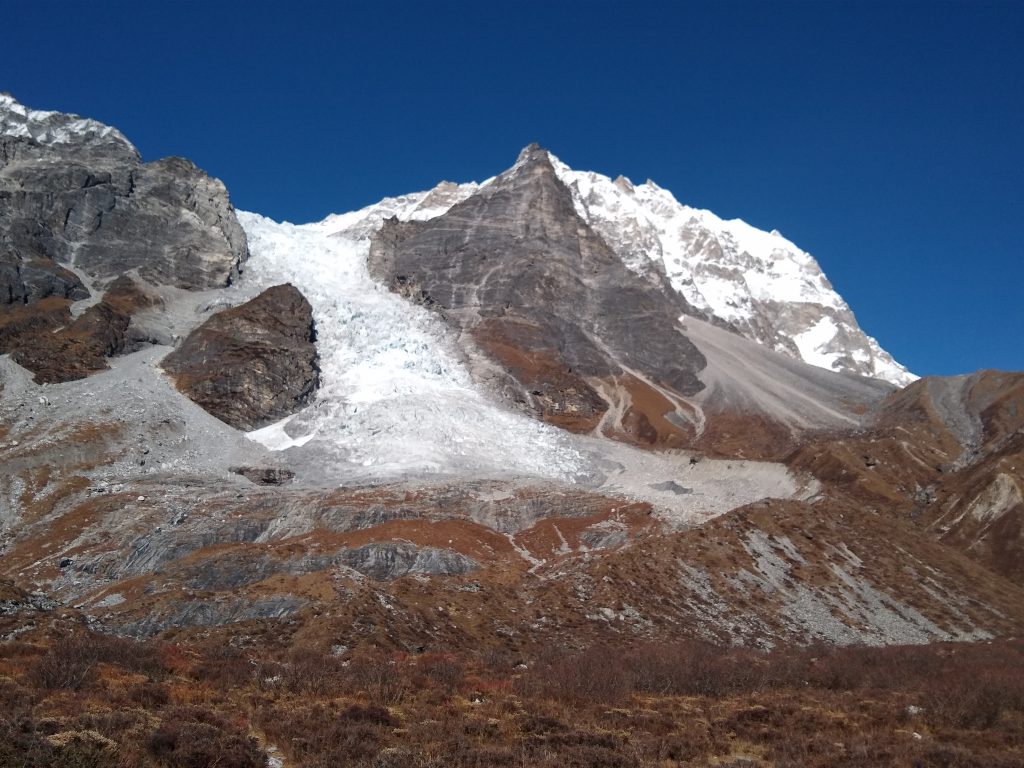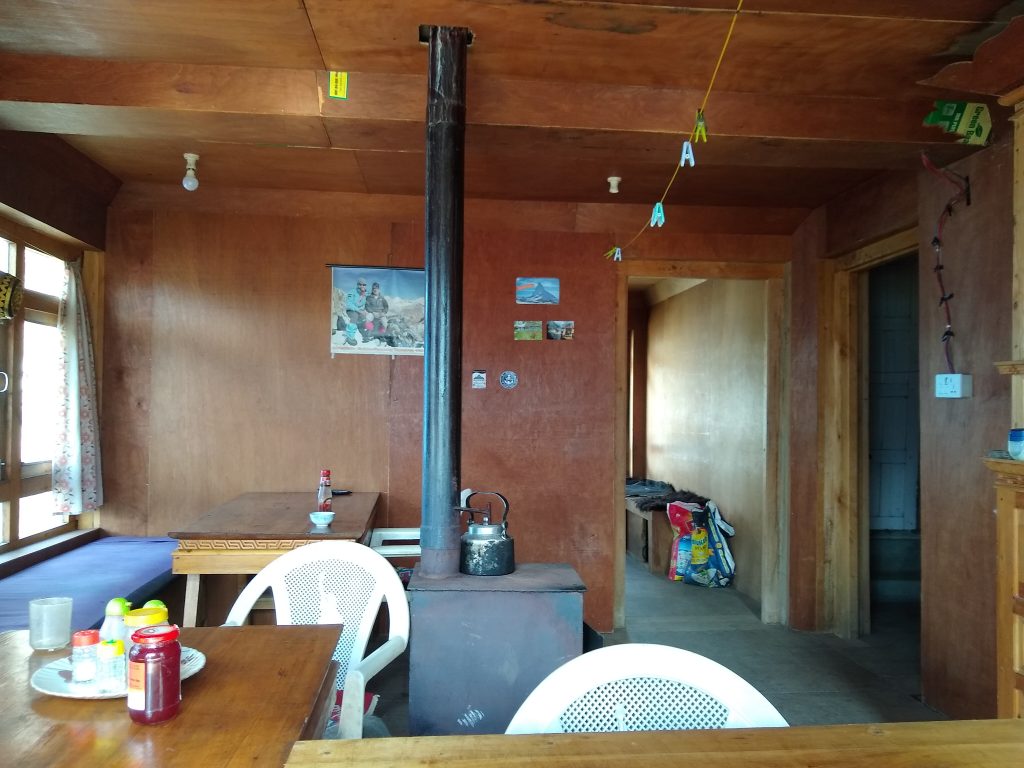The Langtang Region is a much less traveled area of Nepal compared to the Everest Region and the Annapurna Region. You will not encounter crowds of people on the trails, only a small trickle, and the views are just as incredible.
Fast Facts:
Languages: Nepali and English are understood throughout the Langtang Region. The local language in the lower regions is Tamang and in the upper regions is Tibetan.
Currency: Nepalese Rupee (NPR). As of November 2019, 1 USD = 113 NPR.
Getting in: US citizens are eligible for a visa on arrival at any entry point into Nepal. The cost is $30 for 15 days, $50 for 30 days, and $125 for 90 days. All visas are multiple entry and also require a passport-sized photo.
Getting around: The best methods for getting around inside Nepal are shared buses or Jeeps. The cost of both should be less than 100 NPR per hour of driving time. Inside most of the Langtang Region, the only way to get around is by walking.
When to visit: March to May or September to November are ideal months for trekking in Langtang. Summer is cloudy and rainy and winter is very cold and snowy.
How to visit: The main entry point to all treks in Nepal, including the Langtang Region, is Kathmandu. Good deals on paid flights to Kathmandu range from $600 to $1000 if departing from the US. Good deals on paid flights to Delhi in India can range from $400 to $650, and a relatively comfortable bus runs each day between Delhi and Kathmandu for $35 each way and is bookable online or over the phone. Using miles to visit this part of the world is generally not the greatest value, as tickets can cost between 70,000 miles and 85,000 miles round-trip depending on the program. If you have a lot of time and a lot of Alaska Airlines miles, it could make sense to combine a trip to Japan, India, and Nepal by flying from the US to Delhi on Japan Airlines with a stopover in Tokyo on the way there or back, and then taking the bus from Delhi to Kathmandu. This route on Japan Airlines costs 70,000 Alaska Airlines miles round-trip and is bookable online.
Details:
Many people who travel to Nepal and go to the Langtang Region to go trekking do so through package tours or hiring a guide. However, this really is not necessary and can actually harm your experience. By traveling independently, you can interact more genuinely with the locals. In fact, if you take a guide, he will take you to certain hotels along the trekking route which charge room fees, which go directly to the guide as a commission for recommending the hotel. If you trek independently, every hotel and tea house will let you stay for free (only meals are charged), and the places without guided groups usually have warmer hospitality.
Once you get to Kathmandu, you will have to pick up your TIMS card, which costs 2000 NPR for independent trekkers, and your Langtang National Park entrance permit which costs 3000 NPR. The TIMS card application also requires 2 passport size photos. Both the TIMS card and the entrance permit can be obtained at the offices of the Nepal Tourism Board, which is correctly located on Google Maps.
Buses and shared Jeeps are available to the start of the trek at Syabru Besi and leave in the morning from the Machha Pokhari bus stop in the northwest part of Kathmandu. I would recommend arriving by 7 AM to ensure a spot, or booking in person the evening before to ensure a better spot. Buses cost between 600 and 760 NPR and Jeeps are about 100 NPR more. Jeeps are slightly faster. Allow an entire day to arrive into Syabru Besi; depending on the road conditions you may not arrive until after dark. There are plenty of lodging options available in Syabru Besi with no need to reserve ahead of time. The cheaper options will cost 500 NPR for a room. There are also a few nice restaurants in Syabru Besi.
The starting elevation for the trek is 1500 meters or around 5000 feet. The trail follows a river the entire way to the village of Kyangin Gompa (3850 meters/12,600 feet), which is about a 3 day trek if you are in decent shape. Typical overnighting locations are Lama Hotel (a collection of tea houses at 2400 meters/7900 feet) for the first night and Langtang Village (a village at 3400 meters/11,150 feet) for the second night, but tea houses with accommodation are available throughout the trek every hour or so during the trekking season.
In Kyangin Gompa, there is a cheese factory which can be quickly visited, as well as an unused monastery which you can enter if the key holder happens to be in town.
The best part of Kyangin Gompa is the spectacular mountain scenery in all directions. There are many day hikes in every direction from the village and I would recommend staying at least four nights and three full days to explore a bit. The most popular day hike is to summit Kyangin Ri, which has two peaks, a lower one at 4350 meters/14,300 feet and an upper one at 4600 meters/15,100 feet. An easier hike to help with acclimatization is to just walk along the river valley beyond Kyangin Gompa, it is quite flat.
Another day hike that is fairly easy is to walk up to the glacier viewpoint located on Maps.me just north of town. The viewpoint is at about 4175 meters/13,700 feet.
A challenging day hike is to summit Tserko Ri (4950 meters/16,250 feet), which will take several hours and requires proper acclimatization. Many other day hikes are available as well in all directions from Kyangin Gompa.
For more experienced or adventurous trekkers, if you pack a tent with you and carry your own food, it is possible to traverse southward over Ganja La Pass (5200 meters) for several days to arrive back in Kathmandu. Beware that this route passes through Shivapuri Nagarjun National Park, which has a small entry fee payable on arrival. It is also possible to trek southeastward into remote areas through Tilman Pass (5300 meters) but depending on the season this route may require mountaineering skills and is seldom traveled.
The majority of trekkers return to Syabru Besi, which in the downward direction is easily trekkable in two days. Buses and Jeeps to Kathmandu leave during the morning hours.
For accommodation, I recommend the Mountain View Hotel in Langtang village and the Sunrise Guest House in Kyangin Gompa, which are both family owned, have the best amenities including hot showers and western toilets attached to each room, and cater towards independent trekkers rather than guided groups. I explored several other tea houses and hotels in the region, and these ones were the best. You will be approached by many touts offering you business cards and trying to get you to stay in their tea houses, it is best to ignore them and instead stay in these two hotels. In any accommodation in the Langtang Region, rooms should be free and you are only expected to eat dinner and breakfast (400-700 NPR per meal).
What to pack:
- Hiking or backpacking shoes (recommended, although I got by without them)
- Water purification tablets- the water from the taps at the teahouses is safe to drink if treated
- trail snacks and optionally lunches if you are on a tight budget
- toilet paper
- warm clothes and a down jacket/hat, the temperature can drop below freezing at night and be quite windy during the day at higher elevations
- A tent, sleeping bag, sleeping pad, and additional meals only if you plan to spend the night beyond Kyangin Gompa or cross Ganja La or Tilman Passes
- A smartphone with Google Maps and Maps.me offline maps downloaded, and a topographic map of the area especially if you plan to trek beyond Kyangin Gompa
- A power bank to recharge your smartphone, some guesthouses charge a fee for using their plugs
- Cash in Nepalese Rupees (budget 700 NPR per meal you plan to buy, plus money for the bus/jeep and a little bit of extra), you can withdraw this from ATMs in Kathmandu
Understand:
The Langtang region was devastated by earthquakes and landslides in 2015, destroying the old village of Langtang, decimating agricultural output in the area, and making the region dependent on tourism to recover. This is not a bad place to trek, and your money will go to a good cause. Almost every local you meet will have lost a family member in the landslide that destroyed Langtang village, so be considerate when talking with the locals. Most locals in the lower areas are of Tamang ethnicity and in the higher areas are Tibetan ethnicity. You may also meet guided groups with Sherpas from other regions.
Happy trekking!








